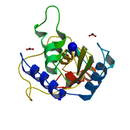| Record Information |
|---|
| Version | 2.0 |
|---|
| Creation Date | 2009-07-06 21:35:46 UTC |
|---|
| Update Date | 2014-12-24 20:25:48 UTC |
|---|
| Accession Number | T3D2640 |
|---|
| Identification |
|---|
| Common Name | Pseudechetoxin |
|---|
| Class | Protein |
|---|
| Description | Pseudechetoxin is a peptide toxin produced by the King brown snake (Pseudechis australis). It blocks olfactory and retinal cyclic nucleotide-gated ion channel currents. (2) |
|---|
| Compound Type | - Amide
- Amine
- Animal Toxin
- Natural Compound
- Organic Compound
- Protein
- Snake Venom
|
|---|
| Protein Structure |  |
|---|
| Synonyms | | Synonym | | CRVP PsTx | | Cysteine-rich venom protein pseudechetoxin |
|
|---|
| Chemical Formula | Not Available |
|---|
| Average Molecular Mass | 26474.445 g/mol |
|---|
| CAS Registry Number | Not Available |
|---|
| Sequence | Not Available |
|---|
| Chemical Taxonomy |
|---|
| Description | Not Available |
|---|
| Kingdom | Organic Compounds |
|---|
| Super Class | Organic Acids |
|---|
| Class | Carboxylic Acids and Derivatives |
|---|
| Sub Class | Amino Acids, Peptides, and Analogues |
|---|
| Direct Parent | Peptides |
|---|
| Alternative Parents | Not Available |
|---|
| Substituents | Not Available |
|---|
| Molecular Framework | Not Available |
|---|
| External Descriptors | Not Available |
|---|
| Biological Properties |
|---|
| Status | Detected and Not Quantified |
|---|
| Origin | Exogenous |
|---|
| Cellular Locations | Not Available |
|---|
| Biofluid Locations | Not Available |
|---|
| Tissue Locations | Not Available |
|---|
| Pathways | Not Available |
|---|
| Applications | Not Available |
|---|
| Biological Roles | Not Available |
|---|
| Chemical Roles | Not Available |
|---|
| Physical Properties |
|---|
| State | Liquid |
|---|
| Appearance | Clear solution. |
|---|
| Experimental Properties | | Property | Value |
|---|
| Melting Point | Not Available | | Boiling Point | Not Available | | Solubility | >10 mg/mL | | LogP | Not Available |
|
|---|
| Predicted Properties | Not Available |
|---|
| Spectra |
|---|
| Spectra | | Spectrum Type | Description | Splash Key | Deposition Date | View |
|---|
|
|---|
| Toxicity Profile |
|---|
| Route of Exposure | Injection (sting/bite) (4) |
|---|
| Mechanism of Toxicity | Pseudechetoxin blocks olfactory and retinal cyclic nucleotide-gated (CNG) ion channel currents. It forms high-affinity contacts with the pore turret region and most likely inhibits CNG channel current by blocking the external entrance to the transmembrane pore. (2) |
|---|
| Metabolism | Free toxin may be removed by opsonization via the reticuloendothelial system (primarily the liver and kidneys) or it may be degraded through cellular internalization via the lysosomes. Lysosomes are membrane-enclosed organelles that contain an array of digestive enzymes, including several proteases. |
|---|
| Toxicity Values | LD50: 1.94 mg/kg (Subcutaneous, Mouse) (5)
LD50: 0.3 mg/kg (Intravenous, Mouse) (5) |
|---|
| Lethal Dose | Not Available |
|---|
| Carcinogenicity (IARC Classification) | No indication of carcinogenicity to humans (not listed by IARC). |
|---|
| Uses/Sources | Pseudechetoxin is a peptide toxin produced by the King brown snake (Pseudechis australis). (2) |
|---|
| Minimum Risk Level | Not Available |
|---|
| Health Effects | Pseudechetoxin is a neurotoxinn and affects sensory transduction in the visual and olfactory systems. (2) |
|---|
| Symptoms | Bites from snakes in the Elapidae family produce pain at the site of the bite, followed by drowsiness, weakness, excessive salivation, decreased blood pressure, difficulty breathing, and paralysis of the facial muscles, lips, tongue, and larynx. In addition, ptosis, blurring of vision, convulsions, and headache may occur. (1) |
|---|
| Treatment | An antivenom exists for brown snake venom. (3) |
|---|
| Normal Concentrations |
|---|
| Not Available |
|---|
| Abnormal Concentrations |
|---|
| Not Available |
|---|
| External Links |
|---|
| DrugBank ID | Not Available |
|---|
| HMDB ID | Not Available |
|---|
| PubChem Compound ID | Not Available |
|---|
| ChEMBL ID | Not Available |
|---|
| ChemSpider ID | Not Available |
|---|
| KEGG ID | Not Available |
|---|
| UniProt ID | Q8AVA4 |
|---|
| OMIM ID | |
|---|
| ChEBI ID | Not Available |
|---|
| BioCyc ID | Not Available |
|---|
| CTD ID | Not Available |
|---|
| Stitch ID | Not Available |
|---|
| PDB ID | 2DDA |
|---|
| ACToR ID | Not Available |
|---|
| Wikipedia Link | Not Available |
|---|
| References |
|---|
| Synthesis Reference | Not Available |
|---|
| MSDS | Not Available |
|---|
| General References | - Dreisbach, RH (1983). Handbook of Poisoning. Los Altos, California: Lange Medical Publications.
- The UniProt Consortium. The Universal Protein Resource (UniProt) Nucleic Acids Res. 2008;36:D190-D195.
- Wikipedia. Antivenom. Last Updated 1 July 2009. [Link]
- Wikipedia. Snake venom. Last Updated 25 July 2009. [Link]
- Thomas S, Griessel E (1999). LD50 Scores for various snakes. [Link]
|
|---|
| Gene Regulation |
|---|
| Up-Regulated Genes | Not Available |
|---|
| Down-Regulated Genes | Not Available |
|---|

